

What does an agile product roadmap look like? – Jeff Gothelf. One of the biggest challenges in product management is planning the work in a linear, visual way.
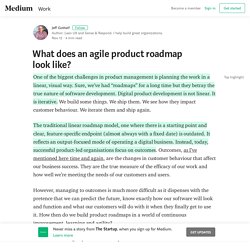
Sure, we’ve had “roadmaps” for a long time but they betray the true nature of software development. Digital product development is not linear. It is iterative. We build some things. We ship them. The traditional linear roadmap model, one where there is a starting point and clear, feature-specific endpoint (almost always with a fixed date) is outdated. However, managing to outcomes is much more difficult as it dispenses with the pretence that we can predict the future, know exactly how our software will look and function and what our customers will do with it when they finally get to use it. Roadmaps und Agile Reporting abseits von Velocity und Story Points. Agile 2017: What i've learned from 10+ years of evaluating Agile cons… Cynefin sensemaking framework and usage examples. What the V Model Can Teach Agilists. Last month, a client and I were sitting in a nondescript conference room in downtown New York.
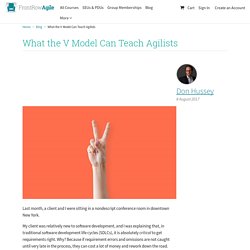
My client was relatively new to software development, and I was explaining that, in traditional software development life cycles (SDLCs), it is absolutely critical to get requirements right. Why? Because if requirement errors and omissions are not caught until very late in the process, they can cost a lot of money and rework down the road. To illustrate my point, I showed him a typical V Model illustration (focusing on requirements elements): The V Model is certainly not new to the world of software development. The conversation ended with my client saying, “All of this is good for you to know, but if you’re working in an agile environment, you won’t have to worry about it.”
Indeed, the V Model has a few things to show us agilists. It Highlights the Importance of Testing. #NoEstimates: The Division of Scrum. Have you encountered the #noestimates hashtag yet?
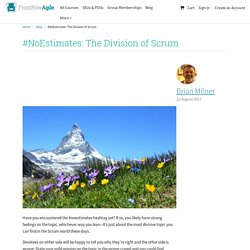
If so, you likely have strong feelings on the topic, whichever way you lean--it’s just about the most divisive topic you can find in the Scrum world these days. Devotees on either side will be happy to tell you why they’re right and the other side is wrong: State your mild opinion on the topic in the wrong crowd and you could find yourself feeling like a Democrat at a Republican convention, or vice versa. At its core, the argument is over the benefit of spending a team’s time on estimating stories. Those who support estimates will tell you it’s a valuable tool that provides businesses with fact-based projections on when a project might be complete. Opponents will say that the benefit of estimating--namely, being able to predict when a project might complete its work--is not worth the time devoted to creating that projection and that a team is better off reclaiming that time to develop software.
The Essence of Agile. One thing that has changed for me over the last few years is that I find myself working with people for whom agile has become the norm.

Indeed, I have even begun to work with people who have never done waterfall. My frames of reference are changing; I am starting to find that comparisons with waterfall don’t carry very much weight these days. Ten years ago, I was working as a test manager on multiple projects, some waterfall in delivery approach, some with agile aspirations that were experimenting with elements of Scrum. Common Pitfalls When Writing BDD Specifications – Nathan Jenan – Medium. Describing the Implementation While not as bad as embedding explicit technical details in your features, describing the implementation can be harmful to your system as well.

Your stories should focus on the “What”, not the “How”. For example, a user does not “click the submit button”, they “submit their resume”. Forming, Storming, Norming and Performing in a Scrum Team. An essential Scrum Master role is to facilitate the formation of new teams, and this is where Tuckman’s “Stages of Group Development” model can help.
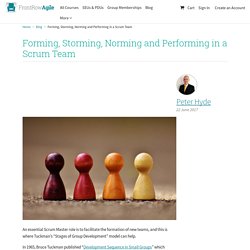
In 1965, Bruce Tuckman published “Development Sequence in Small Groups” which detailed four phases of group development. By understanding the evolution of team behaviour, the Scrum Master can specifically target each phase: Forming: The assembled team discusses the development vision, roadmap and high-level features. Initially, they work independently on tasks and act as a group of people rather than a team. Lacking clear alignment and trust, the team members avoid conflict and instead focus on collecting information and agile planning. The Scrum Master works in the forming stage to promote positive initial team behaviours. Storming: Team members begin to form opinions of each other and start to challenge situations they feel are unfair or wrong. Mathematician George Box once said, “Essentially, all models are wrong, but some are useful.”
Take a bearing, don't estimate - Update - Ralf Westphal. I believe forecasting software development using the Monte Carlo method is even easier than I thought.
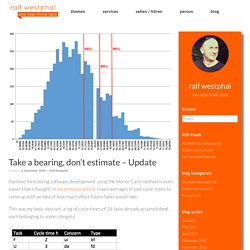
In my previous article I used averages of past cycle times to come up with an idea of how much effort future tasks would take. This was my basic data set: a log of cycle times of 14 tasks already accomplished, each belonging to some category. As a very simple way to calculate an expected effort for future tasks A (UI), K (DOM), E (DA), V (DOM), R (DA), X (UI) I suggested to use the average task cycle time per category. This would lead to A (5h), K (13.75h), E (7.33h), V (13.75h), R (7.33h), X (5h) = 52.17h in total. Creating Your Agile Business Analyst Role. This is the first in a three-part series of blog posts addressing the biggest challenges faced by business analysts on agile teams.
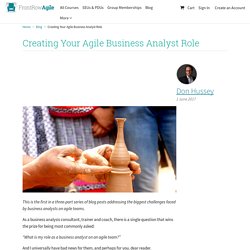
As a business analysis consultant, trainer and coach, there is a single question that wins the prize for being most commonly asked: “What is my role as a business analyst on an agile team?” And I universally have bad news for them, and perhaps for you, dear reader. Budgeting, Estimation, Planning, #NoEstimates and the Agile Planning Onion. There are many levels of estimation including budgeting, high-level estimation and task planning (detailed estimation).
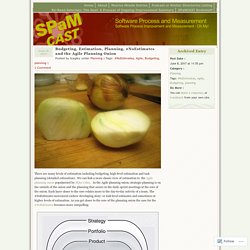
We can link a more classic view of estimation to the Agile planning onion popularized by Mike Cohn. In the Agile planning onion, strategic planning is on the outside of the onion and the planning that occurs in the daily sprint meetings at the core of the onion. Each layer closer to the core relates more to the day-to-day activity of a team. The #NoEstimates movement eschew developing story- or task-level estimates and sometimes at higher levels of estimation.
As you get closer to the core of the planning onion the case for the #NoEstimates becomes more compelling. When will we finish? Using data to forecast when teams will deliver…by Nick Brown – Scrum Master Toolbox Podcast. When will we finish?
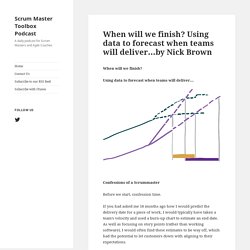
Using data to forecast when teams will deliver… Confessions of a Scrummaster Before we start, confession time. Backlog Refinement – Stefan Willuda – Medium. In den Management-Rahmenwerken Kanban und Scrum hat sich der Einsatz eines Backlog Refinement etabliert. Anders als in den Planning Meetings betrachtet ein Team im Backlog Refinement sein gesamtes Backlog. Ja, richtig, das gesamte Backlog. Definition of Done vs. User Stories vs. Acceptance Criteria. Definition of Done vs. User Stories vs. Acceptance Criteria. Agiler Vertrieb und Agile Sales - Agile Unternehmen. Innerhalb der Softwareentwicklung ist Agilität weit verbreitet.
Doch wie lässt sich der Begriff “Agilität”, den man betriebswirtschaftlich auch mit Flexibilität beschreibt, auf den Vertrieb übertragen? Schauen wir uns doch erst einmal die Definition des Vertriebs an. Das Gabler Wirtschaftslexikon sagt dazu: “Vertrieb beinhaltet v.a. den Verkauf von Waren; Warenverteilung (Logistik, Marketinglogistik), Steuerung der Außendienstorganisation und Pflege der Beziehungen eines Herstellers zum Handel bzw. beim Direktvertrieb (direkter Vertrieb) zum Endkunden. A day (or a sprint) in the life of a BDD team - John Ferguson Smart. Later during the sprint, the team members who will be working on a particular feature or story get together to discuss the detailed requirements. This typically involves in the least a business representative (BA), a developer and a tester. The goal of these “three-amigo” sessions is for the team members to get a deep shared understanding of the business rules and acceptance criteria for the story, and to actively uncover any previously-missed complexity or risk that might trip up subsequent development efforts.
Agile Data Warehousing With The Data Vault – Part 1 – Data Vault and DV 2.0 Education & Training. The Agile Manifesto has 4 core mandates and 12 principles. Before you go jumping the gun and accusing them of being brash, remember they DO value items on the right, however – They value items on the left MORE! The 4 core mandates include: 1. Individuals and Interactions over processes and tools. Aufwandschätzungen mit Story Points bzw. Stunden oder doch eher 'No Estimates'? - agilist. Measuring the Progress of Agile. The eleventh State of Agile survey has just been published by VersionOne. These reports are invaluable in helping agile practitioners understand where their practices, problems and challenges fit the context of the wider world. As with all VersionOne’s previous reports, the eleventh survey paints a picture of the onward march of agile.
Its progress is rarely in a straight line, however, and this latest survey has revealed a very interesting contradiction. The Fear and Vulnerability Retrospective. What makes your teammates lose sleep at night? The best way to find out is simple, but not always easy: ask them! In this post, I’ll be presenting a technique--suitable for a retrospective or a lift off--that opens up channels of communication about the topics of fear and vulnerability. Set the Stage When I run this exercise, I begin with some conceptual groundwork. Leadership & Effective Decision Making on High Performance Teams. Trust, Vision and Ownership In a previous post, I identified "3 Necessary Conditions for 'Going Agile'": Trust, ownership and vision.
There, I used up my quota of blog space by focusing on trust and its impact on a high-performance team. Here, I will continue that voyage by exploring ownership. The Role of a Product Owner (Part 3): Anti-Patterns. Part one of this series examined the responsibilities and characteristics of a product owner; part two looked at their daily activities during a sprint. This third post focuses upon common anti-patterns seen with the product owner role.
Agile Data Warehousing and Business Intelligence in Action. Very often the construction of a Data Warehousing / Business Intelligence (DW / BI) system is performed following the flow of traditional engineering: analysis, design, construction, testing and implementation. Communication between developers and people interested in the business is almost nonexistent, and developers are interested in technologies for working with data but often neglect to ask this most important question: "What business questions do we want to answer with the available data in order to support the decision-making process? " Agile Manifesto Values add on for large enterprises. Autonomie und Orientierung. Agilität braucht Führung. Je mehr Autonomie, desto mehr Führung ist notwendig. Accountability on a Agile Software Development in the Presence of Governance.
Scrum, Kanban, Scrumban – a fast overview and rough categorization when to use what method – OnTheAgilePath. Untitled. An Introduction to Modern Agile. An Introduction to Modern Agile. Independent Testing and Agile Teams. The majority of testing, and in simple situations all of it, is performed by an agile delivery team itself. This is because we strive to have cross-functional “whole teams” that have the capability and accountability to perform the activities of solution delivery from beginning to end. 12 Habits that Will Make You an Excellent Team Lead. The Team Lead Role in an organization that is performing Software Development using DAD is the most influential role and the role can be both challenging and fun.
10 Proven Stakeholder Communication Tactics During An Agile Transition. How to Kick-off Your Agile Transition with Scrum Team #1. User Stories beschreiben Anforderungen statt Bedürfnisse... - agilist. Agile Excel Spreadsheet for the Product Backlog. Forbes Welcome. Agile Data Warehousing and Business Intelligence in Action. Road-mapping Your Way to Agile Fluency. Scrum Breakfast: What's the difference Scrum or Kanban? Tools for Distributed Agile Teams. Managing Requirements Dependencies Between Agile and Lean Teams. Agile Software Development and CapEx/OpEx. Business Value of Agile Data Warehousing User Stories. Advice on How to Split Reporting User Stories. Agile Estimating and Planning. Agility Requires Safety. Upfront Thinking Is Like Insurance. Upfront Thinking Is Like Insurance. Budget When You Can’t Estimate.
Not Everything Needs to Be a User Story: Using FDD Features. How Full to Fill a Sprint. The Agile Rhythm: How to Find Yours & Why. Priority Poker Order. The TAGRI (They Ain't Gonna Read It) Principle of Software Development. Agile Frameworks: Does Anyone Know What A Framework Is? – The Cutter Blog. User stories are not requirements. Scaled Agile Framework – SAFe for Lean Software and System Engineering.
Your Agile Project Needs a Budget, Not an Estimate. Start, Stop, Continue, More of, Less of Wheel - Agile Retrospective Resource Wiki. Agile Retrospective Resource Wiki - Agile Retrospective Resource Wiki. HERMES. Using Scrum & Kanban & SAFe & DSDM (& DAD)
Scrum Data Warehouse Project. Disciplined Agile. Communication and Agile Modeling - Lynn Winterboer Agile Training & Consulting. DSDM Atern. Modern Agile - Industrial Logic. Manifesto for Half-Arsed Agile Software Development. Versprechen, aber richtig. Ich verspreche! Promises, Promises (2014) The Main Benefit of Story Points. How Visual Systems Make It Easier to Track Knowledge Work. Scaling Agile Data Warehousing with the Scaled Agile Framework (SAFe) One Organisational Backlog? Or Two?
Data Warehouse Agility Array Conference2011. Microsoft Designs Team Foundation Server 2015 for Agile, DevOps, ALM. Agile Engineering Stages. Content Access. Are Agile and CMMI compatible? Say goodbye to the old to-do list: kanban is the easiest way to organize projects. Forrester. Got Technical Debt? » Technical Debt. Your Path through Agile Fluency. The Agile Maturity Model (AMM) Atlassian Cloud. The Cultural Impedance Mismatch Between Data Professionals and Application Developers. 7 Obstacles to Enterprise Agility. Modelstorming.com. Outracing BI avalanches - an agile BI success story - diginomica. Memorandum: TDWI - The Data Warehousing Institute. Coaching, Training, & Consulting for Agile Software Organizations. Complexity, Volatility, and Severability of Requirements Determines Agile Applicability. Just enough architecture. Archiv - Detailansicht: TDWI - The Data Warehousing Institute. Pragmatic solutions gmbh – agile coaching & training.